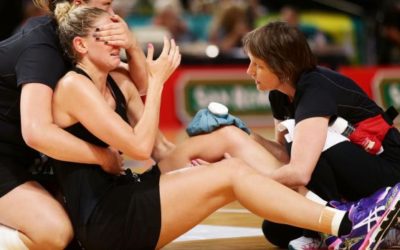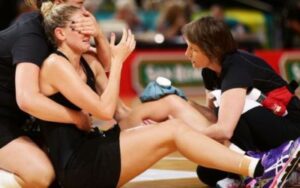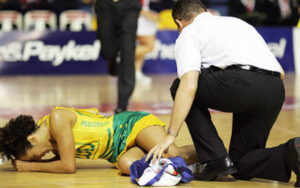Table of Contents
ToggleManaging Injury Risk in Young Netball Athletes
As coaches, parents, and athletes within netball we all know it is high intensity and high-impact game involving acceleration, deceleration, and change of direction whilst performing a range of jumping and landing movements on either one or both legs such as hopping, jumping, leaping, braking, lunging and landing. These actions result in a variety of internal and external forces, which can influence the risk of injury among young netball athletes.
It is important to know forces can be prevented and managed. Forces such as repetitive rapid deceleration between sprint bouts result in a higher eccentric force (lengthening of a muscle under tension rather than contraction) production at the hip, knee, and pelvis, resulting in the potential for increased injury risk. Being quadriceps dominant with weakened hamstrings as a lot of females are in addition to increased internal rotation of the knee can increase stress and loading on the front of the knee. This results in decreased knee stability and impaired protection of the ACL.
Ground Reaction Force
Ground reaction force (GRF) is the force exerted on a body by the ground it is in contact with. High GRF during landing is reported to be a precursor to a knee injury as forces produced are directly transferred to the joints and ligaments of the lower body.
The average GRF for a female netball athlete is approximately 3.9 to 4.3 times body weight (1). This GRF is higher than running, consequently putting the ligaments and joints of the lower limb under undue stress. Excessive braking forces are needed to control abrupt landings in netball to avoid violating the footwork rule. Rapid deceleration and stopping, increased loading on the knee joint, and increased knee injury risk.
During maturation, female sex hormones such as estrogen heighten ACL injury risk in female athletes as they bind to receptors on the ACL. Estrogen decreases collagen production, impacting the laxity of the knee and the ability of the ligaments to absorb forces.
Quadricep to Hamstring Strength Ratio & Subsequent Forces
Female athletes display large imbalances between the quadriceps and hamstring muscles. Research shows this imbalance emerges during puberty, whereby quadriceps strength increases and hamstring strength remains the same (2).
Therefore, young female athletes have a tendency to be quadriceps dominant with decreased knee bending range of motion and increased valgus knee movement (knocked knees) this then causes them to land with straight knees and increases GRF during landing. Female athletes also tend to rely more on the ankle musculature to absorb forces during landing requiring them to have the knee in a more extended position resulting in higher GRF whereas males utilize hip musculature to absorb forces allowing them to land with the knee in a more bent position (3).
Straight knees on landing cause greater GRF due to the disadvantageous position to safely absorb forces. Decreasing landing force translates to reduced force absorption on connective and skeletal structures, decreasing the load on ACL and subsequently ACL injury risk.
The Effect of Maturation & Landing Forces on Netball Athlete Injury Risk
Research has shown that as males mature they actually decrease their landing force. However, the same is not seen in females. As females, mature landing forces do not change despite their body mass increasing which means they have HIGHER landing forces (4) which places them at a higher risk of injury. Plyometric and strength training emphasizing deep knee bending is usually particularly important in reinforcing positive knee alignment and reducing GRF during landing which means a decreased risk of ACL injury.
Managing These Forces to Improve Performance & Prevent Injury
To improve GRF in young female netball athletes a combination of plyometric and strength-based exercises should be included. It is important to note that there is a need to incorporate exercises that emphasize deep knee bending, proper landing technique, and softly absorbing forces to see large decreases in GRF.
Lower body exercises executed under load such as; back squats, lunges, and Romanian deadlifts are important in improving movement patterns and knee joint stabilization in young female netball athletes. Young athletes tend to respond better to high-intensity resistance training (5).
Strength training sessions should be conducted at least twice per week for a minimum of 30 minutes for greater preventative effects. To maintain subsequent strength and performance adaptations, higher loads need to be applied progressively over time. Maximize strength improvements and decrease injury risk by upholding movement quality and technical proficiency at all times. Ensure your sessions are planned and conducted by a trained and qualified strength and conditioning coach.
Strength training is important in improving lower extremity movement patterns in young athletes, it teaches proper landing technique and to safely absorb landing forces which are important in preventing ACL injuries.
References
- Steele JR. The effect of changes to playing surface, footwork rules and throwing technique on ground reaction forces at landing in netball: technical report II – Part A and B. Wollongong: The University of Wollongong, School of Health Science, 1987.
- Quatman-Yates CC, Myer GD, Ford KR, and Hewett TE. A longitudinal evaluation of maturational effects on lower extremity strength in female adolescent athletes. Pediatric Physical Therapy: the official publication of the Section on Pediatrics of the American Physical Therapy Association 25: 271-276, 2013.
- Decker MJ, Torry MR, Wyland DJ, Sterett WI, and Richard Steadman J. Gender differences in lower extremity kinematics, kinetics and energy absorption during landing. Clinical Biomechanics 18: 662-669, 2003.
- Quatman CE, Ford KR, Myer GD, and Hewett TE. Maturation leads to gender differences in landing force and vertical jump performance: a longitudinal study. The American Journal of Sports Medicine 34: 806-813, 2006.
- Lesinski M, Prieske O, and Granacher U. Effects and dose-response relationships of resistance training on physical performance in youth athletes: a systematic review and meta-analysis. British Journal Sports Medicine 50: 781-795, 2016.





